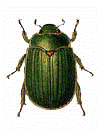Museum, University of Nebraska State
Date of this Version
9-2-1999
Abstract
The endangered American burying beetle, Nicrophorus americanus Olivier, was previously widespread throughout eastern North America. In the past century numbers of this beetle have drastically declined and currently remnant populations are known from only six states despite intensive surveying efforts conducted for the last nine years. Efforts aimed at discovering and managing remnant populations have been generally limited by a lack of knowledge concerning N. americanus biology. We used baited pitfall traps to define the range of the Gothenburg, Nebraska, population of N. americanus. Using mark-recapture techniques, we estimate that the annual Gothenburg population consists of more than one thousand individuals, meeting the recovery plan criterion to become the third breeding population in the Midwest region. Beyond estimates of population size and range, we present novel data on seasonal and daily activity, sex ratio, age-grading and foraging distances. In 1995 and 1996, the Nebraska population was univoltine and female biased, with over-wintering mature beetles emerging in early June and teneral beetles emerging in August. Nocturnal activity was highest in the third and fourth hours following sunset but was not strongly correlated with temperature. During foraging, beetles travel up to six kilometers, but the majority of our recaptures occurred at distances of less than 0.5 km, suggesting that distances between traps be increased to ensure independence of sampling units. This information will allow future work on captive breeding, re-introduction and genetic studies.


Comments
PUBLISHED IN JOURNAL OF INSECT CONSERVATION 3:3 (SEPT 1999), PP. 171-181. ISSN 1366–638X COPYRIGHT © 1999 KLUWER ACADEMIC PUBLISHERS, DIVISION OF SPRINGER VERLAG. USED BY PERMISSION.